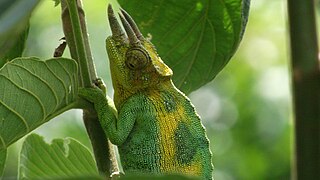
Trioceros johnstoni, known commonly as Johnston's chameleon, Johnston's three-horned chameleon, or the Ruwenzori three-horned chameleon, is an endemic chameleon of the Albertine Rift in Central Africa.

Trioceros melleri, with the common names Meller's chameleon and giant one-horned chameleon, is the largest species of chameleon from the African mainland.

The side-striped chameleon or the two-lined chameleon is a chameleon native to Ethiopia, southern Sudan, Somalia, Kenya, Tanzania, Uganda, and the northeastern Democratic Republic of the Congo.

The coarse chameleon, Trioceros rudis, also known as the rudis chameleon, Ruwenzori side-striped chameleon or the Rwenzori bearded chameleon is a chameleon from western Uganda, Rwanda, Burundi, and eastern DR Congo. Contrary to common belief, this species does not inhabit Mount Meru, Tanzania. Tanzania chameleons called T. rudis are in fact T. sternfeldi.

The West Usambara two-horned chameleon or West Usambara blade-horned chameleon is a chameleon endemic to the West Usambara Mountains of Tanzania. Until 2008, it was generally confused with Fischer's chameleon, which is not found in the Usambara Mountains. Another related species, K. vosseleri, occurs in the same range as K. multituberculata, while K. matschiei is restricted to the East Usambaras.
The spiny-flanked chameleon, Trioceros laterispinis, is a species of chameleon endemic to the United Republic of Tanzania, East Africa. It was first described in 1932 by Arthur Loveridge.

The crested chameleon, Trioceros cristatus, is a species of chameleon endemic to Africa. The species was first described by Samuel Stutchbury in 1837.

Trioceros deremensis, common name Usambara three-horned chameleon and wavy chameleon, is a species of chameleon native to Tanzania.
Trioceros affinis, Rüppell's desert chameleon or beardless Ethiopian montane chameleon, is a species of chameleon endemic to Ethiopia.

Trioceros balebicornutus, the Bale two-horned chameleon, is a species of chameleon endemic to Ethiopia.

Trioceros ellioti, the montane side-striped chameleon or Elliot's groove-throated chameleon, is a species of chameleon found in Burundi, Kenya, South Sudan, Rwanda, Tanzania, Uganda, and Democratic Republic of the Congo.
Trioceros fuelleborni, the Ngosi Volcano chameleon or Poroto three-horned chameleon, is a species of chameleon endemic to Tanzania.
Trioceros goetzei, the Ilolo chameleon or Goetze's whistling chameleon, is a species of chameleon found in Tanzania and Malawi.
Trioceros hanangensis, the Mount Hanang dwarf chameleon or Mount Hanang chameleon, is a species of chameleon found in Tanzania.
Trioceros incornutus, the Ukinga hornless chameleon, is a species of chameleon found in Tanzania.
Trioceros narraioca, the Mount Kulal chameleon or Mount Kulal stump-nosed chameleon, is a species of chameleon endemic to Kenya.
Trioceros nyirit, the Mount Mtelo stump-nosed chameleon or Pokot chameleon, is a species of chameleon endemic to Kenya.
Trioceros schoutedeni, Schouteden's montane dwarf chameleon, is a species of chameleon found in Rwanda and Democratic Republic of the Congo.
Trioceros sternfeldi, the Crater Highlands side-striped chameleon or Tanzanian montane dwarf chameleon, is a species of chameleon found in Tanzania.
Trioceros werneri, Wemer's chameleon or Wemer's three-horned chameleon, is a species of chameleon endemic to Tanzania.










